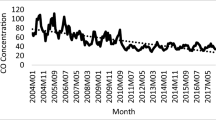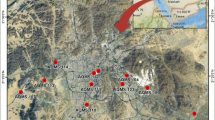Abstract
The monthly maximum of the 24-h average time-series data of ambient air quality—sulphur dioxide (SO2), nitrogen dioxide (NO2) and suspended particulate matter (SPM) concentration monitored at the six National Ambient Air Quality Monitoring (NAAQM) stations in Delhi, was analysed using Box–Jenkins modelling approach (Box et al. 1994). Univariate linear stochastic models were developed to examine the degree of prediction possible for situations where only the past record of pollutant data are available. In all, 18 models were developed, three for each station for each of the respective pollutant. The model evaluation statistics suggest that considerably satisfactory real-time forecasts of pollution concentrations can be generated using the Box–Jenkins approach. The developed models can be used to provide short-term, real-time forecasts of extreme air pollution concentrations for the Air Quality Control Region (AQCR) of Delhi City, India.
Similar content being viewed by others
References
Benarie, M. M. (1980). Urban air pollution modelling. London: The MIT Press.
Benson, P. E. (1979). CALINE 3 A versatile dispersion model for predicting air pollutant levels near highways and arterial roads. Final report. FHWA/CA/TL-79/23. California Department of Transportation, Sacramento, CA.
Benson, P. E. (1989). CALINE 4—a dispersion model for predicting air pollution concentrations near roadways. Final report. FHWA/CA/TL-84/15. California Department of Transportation, Sacramento, CA.
Box, G. E. P., & Jenkins, G. M. (1970). Time series analysis: Forecasting and control (2nd edn.). San Francisco: Holden Day, 1976.
Box, G. E. P., Jenkins, G. M., & Reinsel, G. C. (1994). Time series analysis: Forecasting and control (3rd edn.). Englewood Cliffs, NJ: Prentice Hall.
Cats, G. J., & Holtslag, A. A. M. (1980). Prediction of air pollution frequency distribution—Part 1. The lognormal distribution. Atmospheric Environment, 14, 255–258. doi:10.1016/0004-6981(80)90285-1.
Chock, D. P. (1978). A simple line-source model for dispersion near roadways. Atmospheric Environment, 12, 823–829. doi:10.1016/0004-6981(78)90019-7.
Jakeman, A. J., Simpson, R. W., & Taylor, J. A. (1988). Modelling distributions of air pollutant concentrations - III. The hybrid deterministic-statistical distribution approach. Atmospheric Environment, 22, 163–174. doi:10.1016/0004-6981(88)90309-5.
Juda, K. (1989). Air pollution modelling. In P. N. Cheremisinoff (Ed.), Encyclopedia of environmental control technology, air pollution control (Vol. 2, pp. 83–134). Houston, TX, USA: Gulf Publishing Company.
Marquardt, D. W. (1963). An algorithm for least square estimation of nonlinear parameters. Journal of the Society for Industrial and Applied Mathematics, 11, 431–441. doi:10.1137/0111030.
Mills, T. C. (1991). Time series techniques for economists. Cambridge: Cambridge University Press.
Nieuwstadt, F. T. M. (1980). Prediction of air pollution frequency distribution - II. The Gaussian plume model. Atmospheric Environment, 14, 259–265. doi:10.1016/0004–6981(80)90286–3.
Petersen, W. B. (1980). User’s Guide for HIWAY-2, highway air pollution model, 3–17, EPA-600/8–80–018. Environmental Science Research Laboratory, Office of Research and Development US Environmental Protection Agency, Research Tringle Park, NC, 27711.
Raimondi, F. M., Rando, F., Vitale, M. C., & Calcara, A. M. V. (1997). Short-time fuzzy DAP predictor for air pollution due to vehicular traffic. In R. S. José & C. A. Brebbia (Eds.), Measurements and Modelling in Environmental Pollution. First International Conference on Environmental Pollution MMMEP 97 (pp. 189–200). Southampton, Boston: Computational Mechanics Publications.
Rao, S. T., Sistla, G., Petersen, W. B., Irwin, J. S., & Turner, D. B. (1985). Evaluation of the performance of RAM with the regional air pollution study data base. Atmospheric Environment, 19, 229–245. doi:10.1016/0004-6981(85)90091-5.
Willmott, C. J. (1981). On the validation of models. Physical Geography, 2, 184–194.
Willmott, C. J., Ackleson, S. G., Davis, R. E., Feddema, J. J., Klink, K. M., Legates, D. R., et al. (1985). Statistics for the evaluation and comparison of models. Journal of Geophysical Research, 90, 8995–9005. doi:10.1029/JC090iC05p08995.
Willmott, C. J., & Wicks, D. E. (1980). An empirical method for the spatial interpolation of monthly precipitation within California. Physical Geography, 1, 59–73.
Zannetti, P. (1989). Simulating short-term, short-range air quality dispersion phenomena. In P. N. Cheremisinoff (Ed.), Encyclopedia of environmental control technology, air pollution control (Vol. 2, pp. 159–195). Houston, TX, USA: Gulf Publishing Company.
Author information
Authors and Affiliations
Corresponding author
Rights and permissions
About this article
Cite this article
Sharma, P., Chandra, A. & Kaushik, S.C. Forecasts using Box–Jenkins models for the ambient air quality data of Delhi City. Environ Monit Assess 157, 105–112 (2009). https://doi.org/10.1007/s10661-008-0520-2
Received:
Accepted:
Published:
Issue Date:
DOI: https://doi.org/10.1007/s10661-008-0520-2




